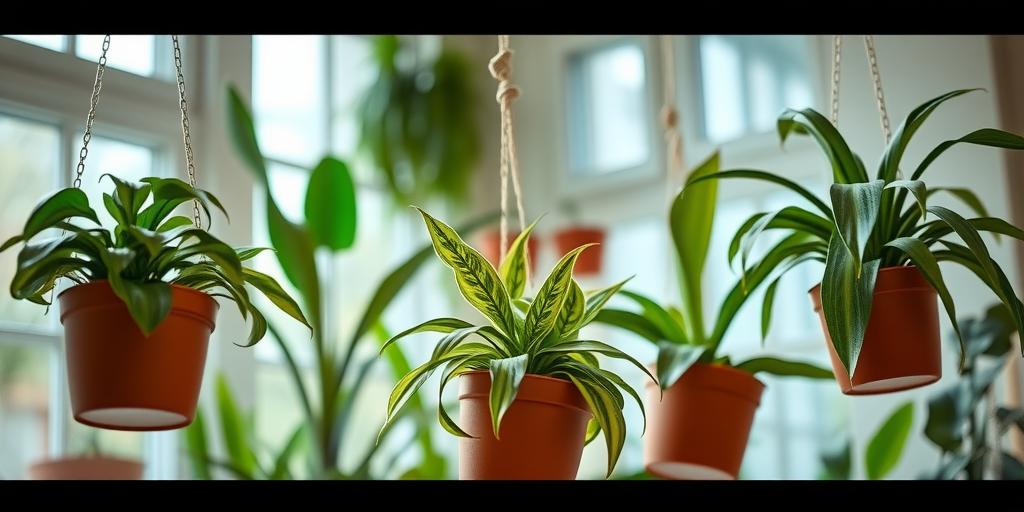
Top Low Light Hanging Plants Safe for Pets and Kids
Discover the best low-light hanging plants that are safe for pets and kids! Perfect for adding greenery to dim spaces without worrying about toxicity.
Introduction
Did you know that over 65% of households in the U.S. own at least one pet? If you’re a plant lover with furry friends or little ones at home, finding safe, low-light hanging plants can be a challenge. But don’t worry—we’ve got you covered! Whether your home lacks bright sunlight or you just want to add some lush greenery to a shady corner, these pet- and kid-friendly hanging plants will thrive effortlessly. Let’s dive in!
Why Choose Low Light Hanging Plants Safe for Pets and Kids?
Hanging plants are a fantastic way to bring life into small or dimly lit spaces where floor space might be limited. They add a touch of greenery without cluttering surfaces, making them perfect for apartments, offices, or rooms with minimal natural light. Plus, they create visual interest by drawing the eye upward, adding depth to your décor.
But if you have pets or young children, plant safety becomes a top priority. Many common houseplants contain toxins that can cause mild to severe reactions if ingested. Choosing non-toxic varieties ensures that even if your curious cat nibbles on a leaf or your toddler decides to taste-test a vine, there won’t be any harmful consequences.
Beyond safety, low-light hanging plants also improve air quality by filtering out pollutants and releasing oxygen. They soften harsh lines in a room, making spaces feel more inviting and cozy. Whether you’re looking to brighten up a dark corner or add a natural touch to your home, pet- and kid-friendly hanging plants are a smart choice.
Best Low Light Hanging Plants Safe for Pets and Kids
Spider Plant (Chlorophytum comosum)
Spider plants are practically indestructible, making them ideal for beginners. They thrive in low to moderate light and can tolerate occasional neglect. Their long, arching leaves produce tiny “pups” that dangle from the mother plant, creating a cascading effect. Best of all, they’re completely non-toxic to pets and kids.
Boston Fern (Nephrolepis exaltata)
If you love lush, feathery foliage, the Boston fern is a great pick. It thrives in humid environments, making it perfect for bathrooms or kitchens. While it prefers indirect light, it can adapt to lower light conditions with consistent moisture. Just keep it out of reach if you have pets who like to bat at dangling fronds—though it’s safe, you don’t want shredded leaves everywhere!
Parlor Palm (Chamaedorea elegans)
This elegant palm adds a tropical vibe to any space and does well in low light. Its delicate fronds are soft to the touch, and it grows slowly, so it won’t overwhelm a small space. Completely pet-safe, it’s a great choice for households with cats or dogs.
Staghorn Fern (Platycerium bifurcatum)
For something a little more unique, the staghorn fern is a showstopper. Its antler-like leaves grow in an eye-catching pattern, and it can be mounted on wood or hung in a basket. It prefers bright, indirect light but can tolerate lower light if watered properly. Plus, it’s completely safe for pets.
Peperomia (Peperomia spp.)
Peperomias come in a variety of shapes and textures, from ripple-leafed varieties to trailing types like the String of Turtles. They’re compact, easy to care for, and thrive in low to medium light. Most importantly, they’re non-toxic, so you don’t have to worry if your pet takes a curious bite.
Baby’s Tears (Soleirolia soleirolii)
This delicate trailing plant forms a dense mat of tiny green leaves, making it perfect for hanging baskets where it can spill over the edges. It loves moisture and does well in low light, though it may grow a bit leggy if the light is too dim. Safe for pets and kids, it’s a charming addition to any room.
Care Tips for Low Light Hanging Plants
Watering Needs
Since low-light plants grow more slowly, they don’t need as much water as those in bright light. Overwatering is a common issue—always check the soil before watering. Stick your finger about an inch deep; if it feels dry, it’s time to water. If it’s still damp, wait a few more days.
Best Soil Types
Good drainage is key to preventing root rot. Use a well-draining potting mix, and consider adding perlite or orchid bark for extra aeration. For ferns and other moisture-loving plants, a peat-based mix helps retain water without becoming soggy.
Fertilizing Schedule
Low-light plants don’t need frequent feeding. A diluted, balanced liquid fertilizer every 4-6 weeks during the growing season (spring and summer) is usually enough. Skip fertilizing in fall and winter when growth slows.
Pruning and Maintenance
Regularly trim yellow or dead leaves to keep your plant healthy. For trailing plants like spider plants or baby’s tears, occasional pruning encourages bushier growth. Wiping leaves with a damp cloth removes dust and helps them absorb light better.
Where to Hang Your Pet-Safe Plants
Best Spots in Low-Light Areas
Bathrooms with small windows are ideal for humidity-loving plants like Boston ferns. Hallways, north-facing windows, or corners away from direct sunlight also work well. Just make sure the spot isn’t completely dark—plants still need some ambient light to thrive.
Creative Hanging Ideas
Macramé hangers add a bohemian touch and keep plants out of reach of pets. Wall-mounted planters or floating shelves can display multiple plants without taking up floor space. For a modern look, try geometric hanging terrariums with air plants (which are also pet-safe!).
Safety Tips
If you have playful pets or toddlers, avoid hanging plants where they can be easily pulled down. Secure hooks properly, and opt for lightweight pots to minimize damage if they do fall. Place heavier plants on high shelves instead of hanging them.
Common Toxic Plants to Avoid
Popular but Dangerous Plants
Some of the most common houseplants are surprisingly toxic. Pothos, philodendrons, and peace lilies can cause mouth irritation, vomiting, or worse if ingested by pets or kids. Even aloe vera, while great for burns, can upset stomachs if eaten.
Symptoms of Plant Toxicity
Watch for drooling, vomiting, diarrhea, or lethargy in pets. In children, symptoms may include rashes, nausea, or mouth swelling. If you suspect ingestion, check the plant’s toxicity level and contact a vet or poison control immediately.
What to Do If Ingestion Occurs
Remove any plant material from the mouth and rinse with water. Call your vet or pediatrician right away—having a photo or sample of the plant can help with identification. For severe reactions, seek emergency care immediately.
By choosing pet- and kid-friendly hanging plants, you can enjoy the beauty of greenery without the worry. With the right care and placement, these plants will thrive and bring life to even the darkest corners of your home.
Conclusion
Adding greenery to your home doesn’t have to be risky! With these low-light hanging plants safe for pets and kids, you can enjoy a lush, vibrant space without worry. Whether you opt for a Spider Plant’s cascading leaves or a Boston Fern’s feathery fronds, there’s a perfect plant for every dim corner. Ready to transform your space? Pick your favorite and start hanging today!
